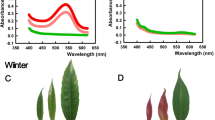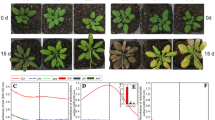Abstract
Anthocyanins and nonphotochemical quenching (NPQ) are two important tools that provide photoprotection in plant leaves. In order to understand how plants use these tools for acclimation to changing seasonal conditions, we investigated pigments, antioxidative capacity, and photosynthesis in leaves of an evergreen tree (Acmena acuminatissima) in two contrasting seasons. Young leaves of A. acuminatissima appeared in distinct colors, being light green in summer and red in winter due to the presence of anthocyanins. In the winter young leaves, anthocyanins contributed less than 2% to the antioxidant pool. In the summer, young leaves had higher NPQ than that of mature leaves, but in the winter, they did not derive any NPQ-related advantage over mature leaves. These results suggest that the accumulation of anthocyanins in young leaves in the winter may compensate for the insufficient photoprotection afforded by NPQ and that anthocyanins function as a light attenuator to protect the photochemical apparatus against excess light.
Similar content being viewed by others
Abbreviations
- C i :
-
intercellular CO2 concentration
- Car:
-
carotenoid
- Chl:
-
chlorophyll
- DPPH:
-
1,1-diphenyl-2-picrylhydrazyl
- E :
-
transpiration rate
- ETR:
-
electron transport rate
- Fv/Fm :
-
maximum photochemical efficiency of PSII
- g s :
-
stomatal conductance
- ML:
-
mature leaves
- NPQ:
-
nonphotochemical quenching
- P N :
-
net light-saturated photosynthetic rate
- ΦPSII :
-
effective photochemical efficiency of PSII
References
Ainsworth E.A., Gillespie K.M.: Estimation of total phenolic content and other oxidation substrates in plant tissues using Folin–Ciocalteu reagent.–Nat. Protoc. 2: 875–877, 2007.
Albert N.W., Lewis D.H., Zhang H. et al.: Light-induced vegetative anthocyanin pigmentation in petunia.–J. Exp. Bot. 60: 2191–2202, 2009.
Bilger W., Björkman O.: Role of the xanthophyll cycle in photoprotection elucidated by measurements of light-induced absorbance changes, fluorescence and photosynthesis in leaves of Hedera canariensis.–Photosynth. Res. 25: 173–185, 19
Bradford M.M.: A rapid and sensitive method for the quantitation of microgram quantities of protein utilizing the principle of protein-dye binding.–Anal. Biochem. 72: 248–254, 1976.
Feild T.S., Lee D.W., Holbrook N.M.: Why leaves turn red in autumn. The role of anthocyanins in senescing leaves of redosier dogwood.–Plant Physiol. 127: 566–574, 2001.
Genty B., Briantais J.M., Baker N.R.: The relationship between the quantum yield of photosynthetic electron transport and quenching of chlorophyll fluorescence.–Biochim. Biophys. Acta 990: 87–92 1989.
Gould K.S., Kuhn D.N., Lee D.W. et al.: Why leaves are sometimes red.–Nature 378: 241–242, 1995.
Gould K.S., Markham K.R., Smith R.H. et al.: Functional role of anthocyanins in the leaves of Quintinia serrata A. Cunn.–J. Exp. Bot. 51: 1107–1115, 2000.
Guo Y.-H., Cao K.-F.: Effect of night chilling on photosynthesis of two coffee species grown under different irradiances.–J. Hortic. Sci. Biotech. 79: 713–716, 2004.
Hakala M., Tuominen I., Keränen M. et al.: Evidence for the role of the oxygen-evolving manganese complex in photoinhibition of photosystem II.–BBA-Bioenergetics 1706: 68–80, 2005.
Havaux M., Kloppstech K.: The protective functions of carotenoid and flavonoid pigments against excess visible radiation at chilling temperature investigated in Arabidopsis npq and tt mutants.–Planta 213: 953–966, 2001.
He J., Yang W., Qin L. et al. Photoinactivation of photosystem II in wild type and chlorophyll b-less barley leaves: Which mechanism dominates depends on experimental circumstances.–Photosynth. Res. 126: 399–407, 2015.
Heimler D., Vignolini P., Dini M.G. et al.: Rapid tests to assess the antioxidant activity of Phaseolus vulgaris L. Dry beans.–J. Agr. Food Chem. 53: 3053–3056, 2005.
Hendrickson L., Ball M.C., Osmond C.B. et al.: Assessment of photoprotection mechanisms of grapevines at low temperature.–Funct. Plant Biol. 30: 631–642 2003.
Hipskind J., Wood K., Nicholson R.L.: Localized stimulation of anthocyanin accumulation and delineation of pathogen ingress in maize genetically resistant Tobipolaris maydisrace O.–Physiol. Mol. Plant Pathol. 49: 247–256, 1996.
Hirotsu N., Makino A., Ushio A. et al.: Changes in the thermal dissipation and the electron flow in the water–water cycle in rice grown under conditions of physiologically low temperature.–Plant Cell Physiol. 45: 635–644, 2004.
Hu W., Song X., Shi K. et al.: Changes in electron transport, superoxide dismutase and ascorbate peroxidase isoenzymes in chloroplasts and mitochondria of cucumber leaves as influenced by chilling.–Photosynthetica 46: 581–588, 2008.
Hughes N.M., Neufeld H.S., Burkey K.O.: Functional role of anthocyanins in high-light winter leaves of the evergreen herb Galax urceolata.–New Phytol. 168: 575–587, 20
Hughes N.M., Morley C.B., Smith W.K.: Coordination of anthocyanin decline and photosynthetic maturation in juvenile leaves of three deciduous tree species.–New Phytol. 175: 675–685, 2007.
Hughes N.M., Smith W.K.: Attenuation of incident light in Galax urceolata (Diapensiaceae): Concerted influence of adaxial and abaxial anthocyanic layers on photoprotection.–Am. J. Bot. 94: 784–790, 2007.
Karageorgou P., Manetas Y.: The importance of being red when young: Anthocyanins and the protection of young leaves of Quercus coccifera from insect herbivory and excess light.–Tree Physiol. 26: 613–621, 2006.
Koćcielniak J., Biesaga-Koćcielniak J.: Photosynthesis and nonphotochemical excitation quenching components of chlorophyll excitation in maize and field bean during chilling at different photon flux density.–Photosynthetica 44: 174–180, 2006.
Krall J.P., Edwards G.E.: Relationship between photosystem II activity and CO2 fixation in leaves.–Physiol. Plantarum 86: 180–187, 1992.
Kratsch H.A., Wise R.R.: The ultrastructure of chilling stress.–Plant Cell Environ. 23: 337–350, 2000.
Kumar V., Sharma S.S.: Nutrient deficiency-dependent anthocyanin development in Spirodela polyrhiza L. Schleid.–Biol. Plantarum 42: 621–624, 1999.
Laine P.L., Bigot J., Ourry A. et al.: napus L.–New Phytol. 127: 675–683, 1994.
Lea U.S., Slimestad R., Smedvig P. et al: Nitrogen deficiency enhances expression of specific MYB and BHLH transcription factors and accumulation of end products in the flavonoid pathway.–Planta 225: 1245–1253, 2007.
Liakopoulos G., Nikolopoulos D., Klouvatou A. et al.: The photoprotective role of epidermal anthocyanins and surface pubescence in young leaves of grapevine (Vitis vinifera).–Ann. Bot.-London 98: 257–265, 2006.
Liu X., Ardo S., Bunning M. et al.: Total phenolic content and DPPH radical scavenging activity of lettuce (Lactuca sativa L.) grown in Colorado.–LWT-Food Sci. Technol. 40: 552–557, 2007.
Mai J., Herbette S., Vandame M. et al.: Effect of chilling on photosynthesis and antioxidant enzymes in Hevea brasiliensis Muell. Arg.–Trees 23: 863–874, 2009.
Mai J., Herbette S., Vandame M. et al.: Contrasting strategies to cope with chilling stress among clones of a tropical tree, Hevea brasiliensis.–Tree Physiol. 30: 1391–1402, 20
Müller P., Li X.-P., Niyogi K.K.: Non-photochemical quenching. A response to excess light energy.–Plant Physiol. 125: 1558–1566, 2001.
Müller-Moulé P., Conklin P.L., Niyogi K.K.: Ascorbate deficiency can limit violaxanthin de-epoxidase activity in vivo.–Plant Physiol. 128: 970–977, 20
Neill S.O., Gould K.S., Kilmartin P.A. et al.: Antioxidant activities of red versus green leaves in Elatostema rugosum.–Plant Cell Environ. 25: 539–547 20
Neill S.O., Gould K.S.: Anthocyanins in leaves: Light attenuators or antioxidants?–Funct. Plant Biol. 30: 865–873, 2003.
Niyogi K.K.: Photoprotection revisited: Genetic and molecular approaches.–Annu. Rev. Plant Phys. 50: 333–359, 1999.
Ohnishi N., Allakhverdiev S.I., Takahashi S. et al.: Two-step mechanism of photodamage to photosystem II: Step 1 occurs at the oxygen-evolving complex and step 2 occurs at the photochemical reaction center.–Biochemistry 44: 8494–8499, 2005.
Oxborough K., Baker N.R.: Resolving chlorophyll a fluorescence images of photosynthetic efficiency into photochemical and non-photochemical components–calculation of qP and Fv’/Fm’; without measuring Fo’.–Photosynth. Res. 54: 135–142 1997.
Peng S., Wang B.: Forest succession of Dinghushan, Guangdong, China.–Chin. J. Bot. 7: 75–80, 1994.
Pietrini F., Iannelli M., Massacci A.: Anthocyanin accumulation in the illuminated surface of maize leaves enhances protection from photo-inhibitory risks at low temperature, without further limitation to photosynthesis.–Plant Cell Environ. 25: 1251–1259, 2002.
Saha M.R, Hasan S.M.R., Akter R. et al.: In vitro free radical scavenging activity of methanol extract of the leaves of Mimusops elengi Linn.–Bangl. J. Vet. Med. 6: 197–202, 2008.
Steyn W.J., Wand S.J., Jacobs G. et al.: Evidence for a photoprotective function of low-temperature-induced anthocyanin accumulation in apple and pear peel.–Physiol. Plantarum 136: 461–472, 2009.
Tucić B., Vuleta A., Jovanović S.M.: Protective function of foliar anthocyanins: In situ experiments on a sun-exposed population of Iris pumila L. (Iridaceae).–Pol. J. Ecol. 57: 779–783, 2009.
van den Berg A.K., Perkins T.D.: Contribution of anthocyanins to the antioxidant capacity of juvenile and senescing sugar maple (Acer saccharum) leaves.–Funct. Plant Biol. 34: 714–719, 2007.
Wang L.-Z., Wang L.-M., Xiang H.-T. et al.: Relationship of photosynthetic efficiency and seed-setting rate in two contrasting rice cultivars under chilling stress.–Photosynthetica 54: 581–588, 2016.
Wellburn A.R.: The spectral determination of chlorophylls a and b, as well as total carotenoids, using various solvents with spectrophotometers of different resolution.–J. Plant Physiol. 144: 307–313, 1994.
Zeng X.Q., Chow W.S., Su L.J. et al.: Protective effect of supplemental anthocyanins on Arabidopsis leaves under high light.–Physiol. Plantarum 138: 215–225, 2010.
Zhang K.-M., Yu H.-J., Shi K. et al.: Photoprotective roles of anthocyanins in Begonia semperflorens.–Plant Sci. 179: 202–208, 20
Zhang Q., Zhang T.-J., Chow W.S. et al.: Photosynthetic characteristics and light energy conversions under different light environments in five tree species occupying dominant status at different stages of subtropical forest succession.–Funct. Plant Biol. 42: 609–619, 2015.
Zhang T.-J., Chow W.S., Liu X.-T. et al: A magic red coat on the surface of young leaves: Anthocyanins distributed in trichome layer protect Castanopsis fissa leaves from photoinhibition.–Tree Physiol. 36: 1296–1306, 2016.
Author information
Authors and Affiliations
Corresponding authors
Additional information
Acknowledgements: This work was funded by the National Natural Science Foundation of China (31570398, 31270287). The study was also supported by the key program of Guangdong Province Natural Science Foundation (2014A070713039; 2015A030311023; 2016A030303063)
Rights and permissions
About this article
Cite this article
Zhu, H., Zhang, TJ., Zheng, J. et al. Anthocyanins function as a light attenuator to compensate for insufficient photoprotection mediated by nonphotochemical quenching in young leaves of Acmena acuminatissima in winter. Photosynthetica 56, 445–454 (2018). https://doi.org/10.1007/s11099-017-0740-1
Received:
Accepted:
Published:
Issue Date:
DOI: https://doi.org/10.1007/s11099-017-0740-1




